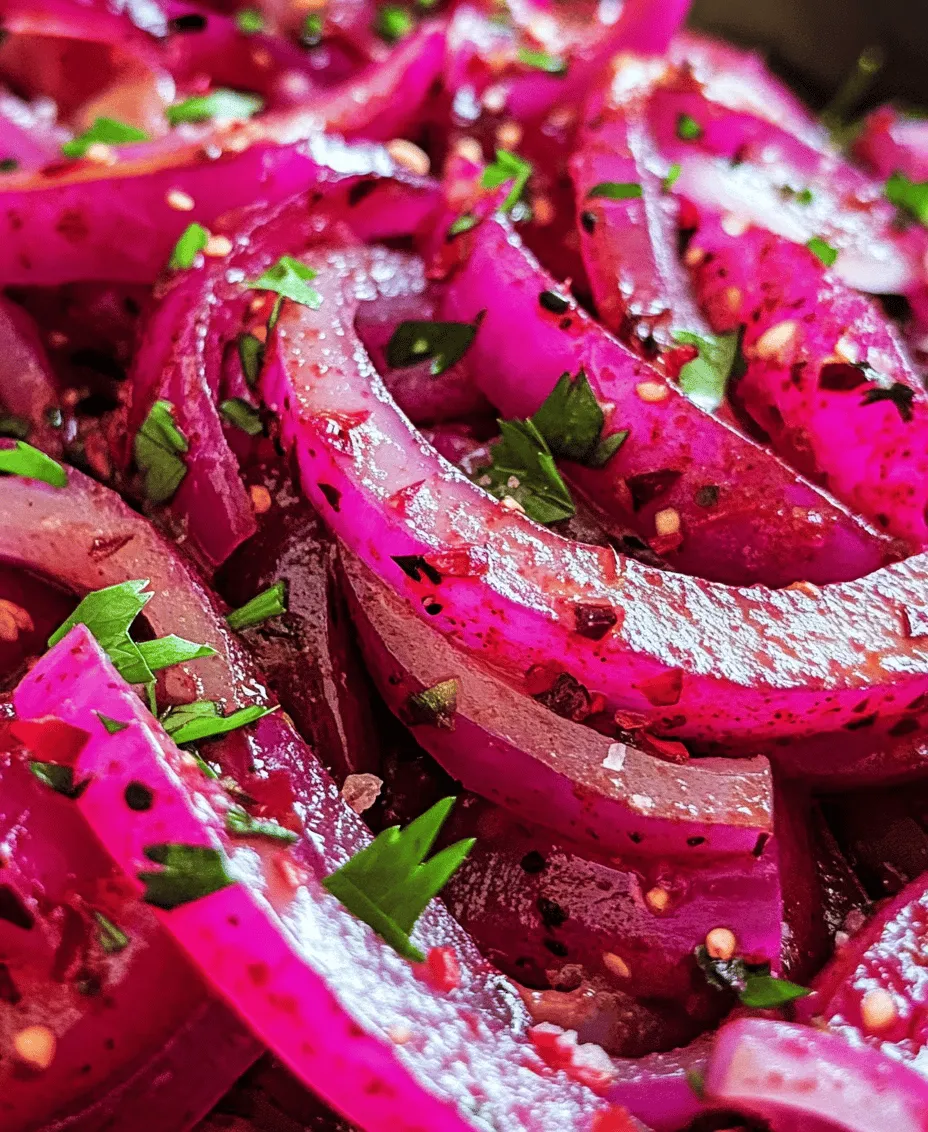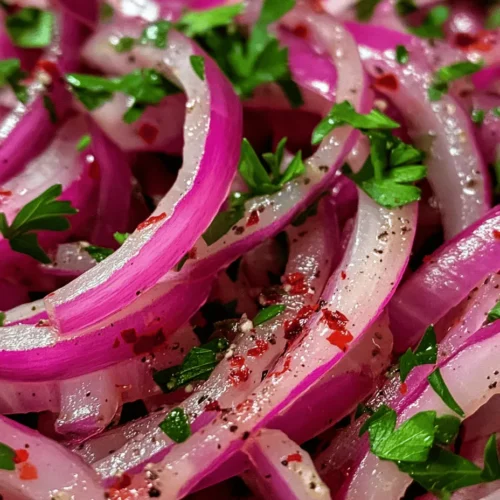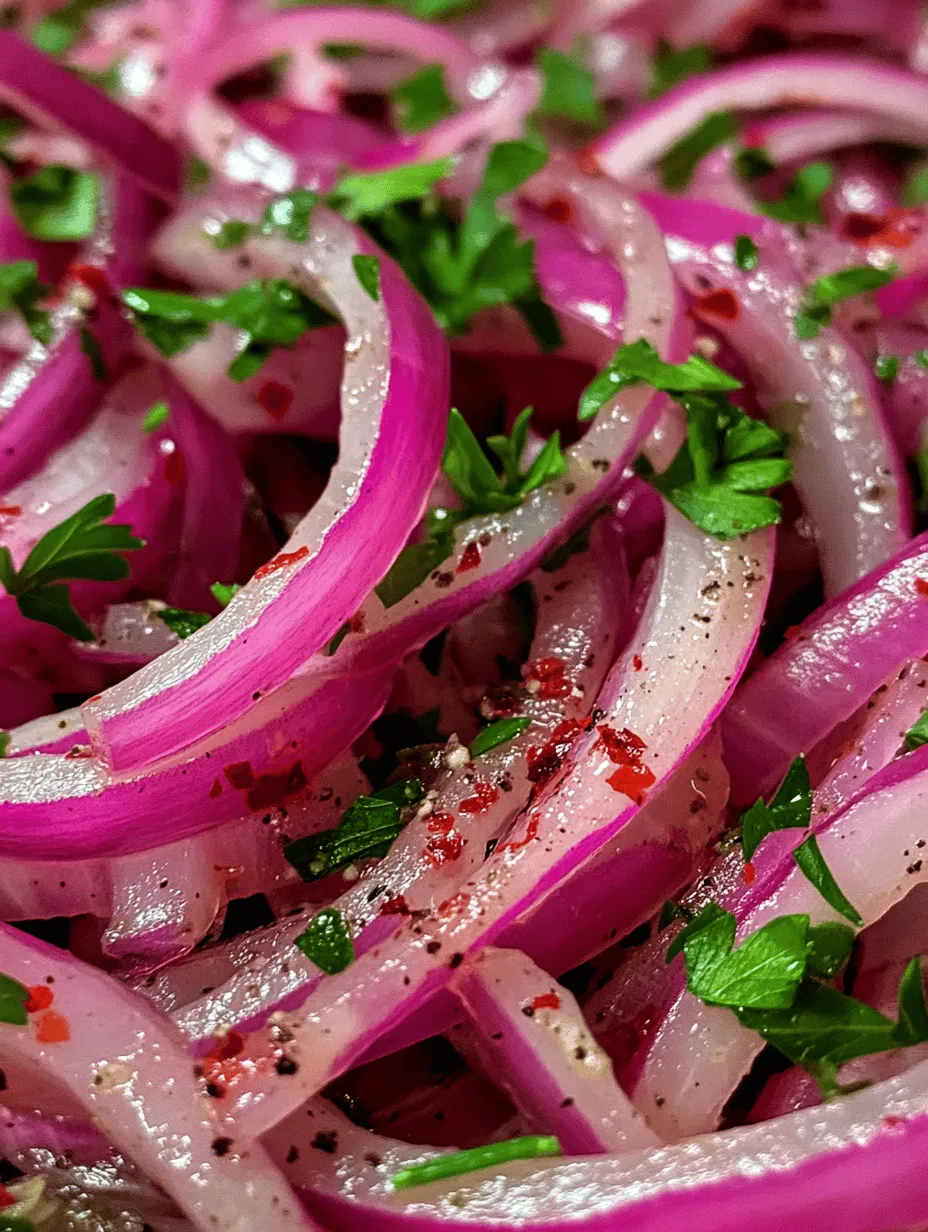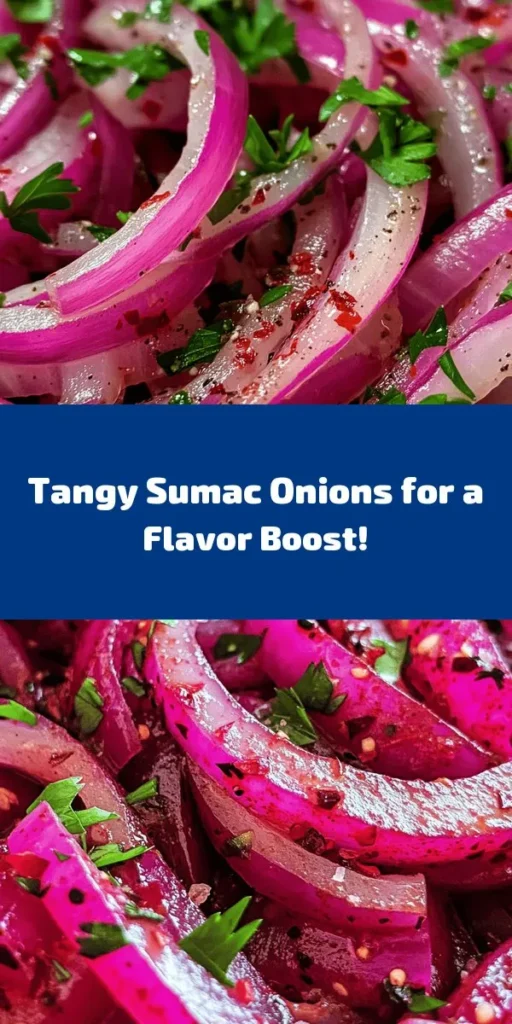Introduction
In the realm of culinary delights, few dishes manage to capture the essence of vibrant flavors quite like Sumac Onions Delight. This enticing recipe showcases the rich, tangy notes of sumac paired with the robust sweetness of red onions, creating a side dish or topping that can elevate any meal. Imagine the burst of flavor as you take a bite, the onions tender yet crisp, and the sumac providing a zesty kick that dances on your palate. Whether served alongside grilled meats, as a topping for a refreshing salad, or as part of a mezze platter, this dish proves its versatility time and again.
But beyond its irresistible taste, Sumac Onions Delight is a celebration of healthful ingredients. Onions are not just a staple in kitchens around the world; they are also packed with antioxidants and nutrients that can contribute to overall well-being. Similarly, sumac, with its bright crimson hue, boasts a range of health benefits, including anti-inflammatory properties that can support a healthy lifestyle. With these ingredients at play, this dish is not only a feast for the senses but also a nourishing addition to your diet.
In this article, we will guide you through the steps to create your own Sumac Onions Delight. From understanding the key ingredients to preparing and serving this delightful dish, you’ll be equipped to bring a touch of Middle Eastern flair to your kitchen.
Understanding the Ingredients
Before diving into the preparation of Sumac Onions Delight, it’s essential to familiarize ourselves with the key components that make this dish unique. Each ingredient plays a significant role, contributing to the flavor profile and health benefits that define this delightful recipe.
Red Onions
Red onions are the star of the show in Sumac Onions Delight, and for good reason. Their distinctive purple skin and white flesh not only add a beautiful color contrast to the dish but also impart a sweet, slightly spicy flavor that deepens with cooking. In comparison to other onion varieties, red onions are milder, making them a preferred choice for raw applications like salads and salsas.
From a health perspective, red onions are rich in antioxidants, particularly quercetin, which is known for its anti-inflammatory and immune-boosting properties. They also contain vitamins C and B6, manganese, and dietary fiber. Incorporating red onions into your meals can help support heart health, improve digestion, and provide a range of nutrients essential for overall well-being.
Culinary-wise, red onions shine in various cuisines, from Mediterranean dishes to Asian stir-fries. Their versatility allows them to be pickled, grilled, roasted, or simply sliced raw, providing a range of flavors and textures that can complement any dish.
Sumac
Sumac is the secret ingredient that takes Sumac Onions Delight to the next level. This spice, native to the Middle East, is made from the dried and ground berries of the sumac plant. Its tangy flavor profile, often described as lemony or sour, adds a unique twist that brightens the dish and enhances its overall appeal.
Beyond its flavor, sumac is celebrated for its health benefits. It is rich in antioxidants, which help combat oxidative stress and inflammation in the body. Traditionally, sumac has also been used to aid digestion and support heart health. Its versatility extends beyond this dish; it can be sprinkled on meats, salads, or even used to season hummus, making it a valuable addition to any spice cabinet.
Additional Ingredients
While the red onions and sumac are the highlights of this dish, several additional ingredients play crucial roles in enhancing its flavor and presentation:
– Olive Oil: A staple in Mediterranean cooking, olive oil adds richness and depth to the dish. It not only coats the onions, allowing them to absorb flavors but also provides healthy fats that can support heart health.
– Lemon Juice: The bright acidity of lemon juice complements the tanginess of sumac, balancing the overall flavor. It also helps to tenderize the onions, making them softer and more palatable.
– Honey: A touch of sweetness from honey helps to offset the acidity and bitterness of the onions, creating a harmonious balance. It also adds a subtle complexity to the flavor profile.
– Parsley: Fresh parsley not only adds a pop of color but also introduces a fresh, herbaceous note that elevates the dish. Its vibrant green complements the deep purple of the onions beautifully.
– Black Pepper: A common seasoning, black pepper enhances the overall flavor, adding a subtle heat that rounds out the dish.
– Chili Flakes: For those who enjoy a bit of spice, chili flakes can be added to give the dish an extra kick. This ingredient is entirely optional but can be adjusted according to personal preference.
Together, these ingredients create a symphony of flavors, transforming simple onions into a delightful dish that can stand on its own or complement a wide variety of meals.
Preparation Steps
Now that we’ve explored the ingredients, it’s time to roll up our sleeves and prepare Sumac Onions Delight. Follow these step-by-step instructions to create this vibrant dish that will impress your family and friends.
Preparing the Onions
The first step in creating Sumac Onions Delight is properly preparing the red onions. The way you slice the onions can significantly impact their flavor absorption and texture in the final dish.
1. Choose Fresh Onions: Start by selecting firm, unblemished red onions. The fresher the onions, the better the flavor and texture.
2. Peeling: Remove the outer skin of the onions and discard it.
3. Slicing Techniques: For this recipe, thinly slice the onions into half-moons or rings, approximately 1/8-inch thick. This size ensures that the onions will marinate effectively, allowing the flavors to penetrate while still retaining a satisfying crunch.
4. Soaking in Water: To reduce some of the sharpness of the red onions, soak the sliced onions in cold water for about 10-15 minutes. This step helps to mellow their flavor, making them more palatable, especially for raw applications.
5. Draining: After soaking, drain the onions and pat them dry with a clean kitchen towel. This step is crucial to ensure that excess moisture does not dilute the marinade.
Seasoning the Onions
Once the onions are prepared, the next step is to season them with a blend of complementary flavors.
1. In a Mixing Bowl: Place the drained, sliced onions into a large mixing bowl.
2. Adding Olive Oil: Drizzle a generous amount of extra virgin olive oil over the onions. The oil will help carry the flavors of the other ingredients while also adding richness.
3. Incorporating Sumac: Sprinkle a liberal amount of sumac over the onions. The tangy flavor of the sumac is what sets this dish apart, so be sure to use enough to coat the onions evenly.
4. Adding Lemon Juice: Squeeze fresh lemon juice over the mixture. The acidity will help soften the onions while enhancing their flavor.
5. Sweetening with Honey: Drizzle a small amount of honey over the onions. This will counterbalance the acidity and add a touch of sweetness.
6. Seasoning with Black Pepper and Chili Flakes: Add freshly ground black pepper to taste, along with optional chili flakes if you prefer a little heat.
7. Chopping Fresh Parsley: Finely chop a handful of fresh parsley and add it to the bowl. This will not only brighten the flavor but also add a fresh color contrast.
Marinating
With the onions properly seasoned, it’s time to marinate them, allowing the flavors to meld together and intensify.
1. Tossing the Ingredients: Using your hands or a spatula, gently toss the onions and seasonings together until everything is evenly coated. Be careful not to bruise the onions too much during this process.
2. Letting it Rest: Cover the bowl with plastic wrap or a lid and let it sit for at least 30 minutes at room temperature. This resting time is crucial, as it allows the flavors to develop and the onions to become tender.
3. Optional Refrigeration: For an even more pronounced flavor, consider refrigerating the marinated onions for a couple of hours or overnight. This will deepen the flavor and improve the overall texture.
Serving Suggestions
One of the most appealing aspects of Sumac Onions Delight is its adaptability. This dish can be served in various ways, making it a perfect addition to any meal.
1. As a Side Dish: Serve the marinated onions alongside grilled meats, roasted vegetables, or fish. The tangy flavor of the onions adds a refreshing contrast to rich and savory dishes.
2. Topping for Salads: Use the marinated onions as a topping for salads, adding a burst of flavor and texture. They pair particularly well with leafy greens, cherry tomatoes, and feta cheese.
3. Part of a Mezze Platter: Include Sumac Onions Delight as part of a mezze platter, alongside hummus, baba ghanoush, olives, and pita bread. This combination creates a delightful spread for gatherings and parties.
4. In Tacos or Wraps: Add the marinated onions to tacos or wraps for a zesty kick that complements meats, beans, and fresh vegetables.
5. As a Garnish: The colorful and flavorful onions can also be used as a garnish for soups and stews, adding a fresh element to hearty dishes.
With its vibrant colors, bold flavors, and numerous serving possibilities, Sumac Onions Delight is sure to become a favorite in your culinary repertoire.
Stay tuned as we delve deeper into the flavor profiles and perfect pairings for this delightful dish in the next section.

Flavor Pairings for Sumac Onions Delight
Sumac Onions Delight is not only a delectable dish on its own but also a versatile accompaniment that enhances a variety of meals. Its tangy flavor profile and crunchy texture make it an exceptional addition to numerous dishes. Here’s how you can incorporate this delightful creation into your culinary repertoire.
As a Side Dish
One of the simplest ways to enjoy Sumac Onions Delight is as a side dish. The zesty flavor of sumac complements a range of grilled meats, making it an ideal partner for your barbecue gatherings. Consider serving it alongside:
– Grilled Meats: The acidity of the sumac onions cuts through the richness of grilled lamb, chicken, or beef, adding a refreshing contrast that elevates the entire meal. The tartness enhances the smoky flavors of the meat, making every bite more flavorful.
– Roasted Vegetables: Pairing Sumac Onions Delight with roasted vegetables such as carrots, bell peppers, or eggplants brings a delightful balance of flavors. The roasted sweetness of the vegetables contrasts beautifully with the sharpness of the onions, creating a harmonious dish.
– Middle Eastern Dishes: This onion dish shines when served alongside traditional Middle Eastern fare like kebabs, falafel, or shawarma. The bright, bold flavors of the sumac onions enhance the spices commonly found in these dishes, making them even more enjoyable.
In Sandwiches and Wraps
Sumac Onions Delight is also perfect for elevating your sandwiches and wraps. Here are a few ideas to inspire your next lunch:
– Fresh Sandwiches: Spread a layer of creamy hummus or tzatziki on your favorite bread, then add a generous scoop of Sumac Onions Delight. This combination not only adds flavor but also a satisfying crunch. Pair with grilled chicken or roasted vegetables for a complete meal.
– Wraps: Incorporate the sumac onions into wraps filled with grilled meats, fresh greens, and other colorful vegetables. The tangy onions will add a refreshing zing that complements the richness of the protein while keeping the wrap light and vibrant.
– Salads: Toss a handful of Sumac Onions Delight into your salads for an unexpected twist. It can provide a punch of flavor that enhances a simple green salad, grain bowl, or even a pasta salad.
Enhancements and Variations
While the classic Sumac Onions Delight recipe is delicious as is, there’s always room for creativity in the kitchen. Here are some enhancements and variations to consider:
– Herbs and Spices: Experiment with adding fresh herbs like parsley, mint, or cilantro to your sumac onions for added freshness. Alternatively, sprinkle in spices like cumin or coriander to introduce new flavor dimensions.
– Add Fruits or Nuts: For a unique twist, consider incorporating pomegranate seeds or chopped nuts such as walnuts or pistachios. These additions can provide sweetness and crunch, enhancing the overall texture and flavor profile of the dish.
– Different Types of Onions: While red onions are commonly used for their color and sweetness, feel free to explore other onion varieties. Shallots offer a milder flavor, while white or yellow onions can provide a sharper taste. Each choice will slightly alter the final dish, allowing you to personalize it to your liking.
Cultural Significance of Sumac
Sumac holds a significant place in the culinary traditions of various cultures, particularly in Middle Eastern and Mediterranean cuisines. Understanding its cultural context can enhance your appreciation of this ingredient and the dishes that incorporate it.
Historical Background
Historically, sumac has been used for centuries, dating back to ancient times where it was revered for its unique flavor and potential health benefits. This spice, derived from the dried berries of the sumac plant, has been a staple in Middle Eastern cooking for generations. It was often used to season meats and vegetables, providing a citrus-like tang before the advent of lemons in the region.
In traditional dishes, sumac is considered a symbol of hospitality and is frequently sprinkled over meals to enhance flavor and aesthetics. Its vibrant red color adds visual appeal, making it a popular choice for both cooks and diners alike.
Culinary Traditions
Different cultures utilize sumac and onions in a variety of ways, showcasing the ingredient’s versatility:
– Middle Eastern Cuisine: In Middle Eastern cooking, sumac is often combined with other spices to create a spice blend known as za’atar, which is used in everything from bread to grilled meats. Onions are frequently caramelized or pickled, adding depth to dishes like shawarma and kabobs.
– Mediterranean Influence: In Mediterranean regions, sumac is used as a condiment to sprinkle over salads, grilled fish, and vegetables. The tartness of sumac complements the rich olive oils and fresh produce that characterize this cuisine.
– Modern Fusion Cooking: Today, chefs around the world are incorporating sumac into contemporary dishes, blending its traditional usage with new culinary trends. This adaptability speaks to the timeless appeal of both sumac and onions in the kitchen.
Health Benefits
Beyond its culinary appeal, Sumac Onions Delight comes with a host of health benefits, making it not only delicious but also nutritious.
Nutritional Profile of Onions
Onions are nutrient-dense vegetables that offer various health benefits. Here’s a breakdown of some key nutrients found in onions:
– Vitamins: Onions are rich in vitamin C, which supports immune function and skin health. They also contain B vitamins, including folate and vitamin B6, which are vital for energy metabolism and brain health.
– Minerals: Onions are a good source of potassium, which helps regulate blood pressure and supports heart health. They also provide small amounts of calcium and magnesium, essential for bone health.
– Antioxidants: Onions are packed with antioxidants, particularly quercetin, which has anti-inflammatory properties and may help reduce the risk of chronic diseases.
Sumac’s Health Properties
Sumac is not only a flavorful spice but also offers potential health benefits:
– Digestive Health: Sumac has been traditionally used to aid digestion. Its tart flavor can stimulate digestive juices, promoting better digestion and nutrient absorption.
– Anti-Inflammatory Effects: Studies suggest that sumac may have anti-inflammatory properties, potentially benefiting those with inflammatory conditions. Its high antioxidant content also contributes to overall health and wellness.
– Blood Sugar Regulation: Some research indicates that sumac may help regulate blood sugar levels, making it a valuable addition to the diet for individuals with diabetes or those looking to maintain stable blood sugar.
Conclusion
Sumac Onions Delight is a versatile and flavorful dish that can elevate any meal with its zesty flavor and delightful crunch. Whether served as a side dish, incorporated into sandwiches, or enjoyed in various cultural cuisines, this dish offers endless possibilities.
The cultural significance of sumac in Middle Eastern and Mediterranean cooking underscores its timeless appeal, while the health benefits associated with onions and sumac add a nutritious element to your meals. By trying this recipe, you not only indulge in a delicious culinary experience but also embrace a tradition that spans generations. So why not prepare Sumac Onions Delight today and savor the delightful combination of flavors that it brings to your table?



